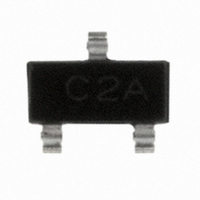HSMS-2822-TR1G Avago Technologies US Inc., HSMS-2822-TR1G Datasheet - Page 8

HSMS-2822-TR1G
Manufacturer Part Number
HSMS-2822-TR1G
Description
DIODE SCHOTTKY RF SER 15V SOT-23
Manufacturer
Avago Technologies US Inc.
Datasheet
1.HSMS-2823-BLKG.pdf
(15 pages)
Specifications of HSMS-2822-TR1G
Package / Case
SOT-23-3, TO-236-3, Micro3™, SSD3, SST3
Diode Type
Schottky - 1 Pair Series Connection
Voltage - Peak Reverse (max)
15V
Current - Max
1A
Capacitance @ Vr, F
1pF @ 0V, 1MHz
Resistance @ If, F
12 Ohm @ 5mA, 1MHz
Product
Schottky Diodes
Peak Reverse Voltage
15 V
Forward Continuous Current
1 A
Configuration
Dual Series
Forward Voltage Drop
0.5 V @ 0.01 A
Maximum Reverse Leakage Current
0.1 uA @ 1 V
Operating Temperature Range
+ 150 C
Mounting Style
SMD/SMT
Capacitance Ct
1pF
Diode Case Style
SOT-23
No. Of Pins
3
Breakdown Voltage
15V
Forward Voltage
340mV
Leaded Process Compatible
Yes
Rohs Compliant
Yes
Forward Current If Max
1A
Forward Voltage Vf Max
340mV
Lead Free Status / RoHS Status
Lead free / RoHS Compliant
Power Dissipation (max)
-
Lead Free Status / Rohs Status
Lead free / RoHS Compliant
Other names
516-1818-2
HSMS-2822-TR1G
HSMS-2822-TR1G
Available stocks
Company
Part Number
Manufacturer
Quantity
Price
Company:
Part Number:
HSMS-2822-TR1G
Manufacturer:
AVAGO
Quantity:
5 667
Company:
Part Number:
HSMS-2822-TR1G
Manufacturer:
AVAGO
Quantity:
2 000
Part Number:
HSMS-2822-TR1G
Manufacturer:
AVAGO/安华高
Quantity:
20 000
RF in
Figure 19. Schematic of Suppressed Harmonic Detector.
Figure 20. Layout of Suppressed Harmonic Detector.
Note that the forgoing discussion refers to the output volt‑
age being extracted at point V+ with respect to ground. If
a differential output is taken at V+ with respect to V‑, the
circuit acts as a voltage doubler.
Mixer applications
The HSMS‑282x family, with its wide variety of packaging,
can be used to make excellent mixers at frequencies up
to 6 GHz.
The HSMS‑2827 ring quad of matched diodes (in the SOT‑143
package) has been designed for double balanced mixers.
The smaller (SOT‑363) HSMS‑282R ring quad can similarly
be used, if the quad is closed with external connections as
shown in Figure 21.
LO in
Figure 21. Double Balanced Mixer.
Both of these networks require a crossover or a three di‑
mensional circuit. A planar mixer can be made using the
SOT‑143 crossover quad, HSMS‑2829, as shown in Figure
22. In this product, a special lead frame permits the cross‑
over to be placed inside the plastic package itself, elimi‑
nating the need for via holes (or other measures) in the RF
portion of the circuit itself.
8
4.7 KΩ
100 pF
68 Ω
V+
C1 = C2 ≈ 100 pF
R1 = R2 = R3 = R4 = 4.7 KΩ
D1 & D2 & D3 & D4 = HSMS-282R
HSMS-282R
C2
D2
R3
RF in
HSMS-282R
R4
D1
D4
V–
68 Ω
C1
100 pF
4.7 KΩ
IF out
V–
R1
RF in
R2
V+
D3
LO in
Figure 22. Planar Double Balanced Mixer.
A review of Figure 21 may lead to the question as to why
the HSMS‑282R ring quad is open on the ends. Distor‑
tion in double balanced mixers can be reduced if LO drive
is increased, up to the point where the Schottky diodes
are driven into saturation. Above this point, increased LO
drive will not result in improvements in distortion. The use
of expensive high barrier diodes (such as those fabricated
on GaAs) can take advantage of higher LO drive power,
but a lower cost solution is to use a eight (or twelve) diode
ring quad. The open design of the HSMS‑282R permits this
to easily be done, as shown in Figure 23.
LO in
Figure 23. Low Distortion Double Balanced Mixer.
This same technique can be used in the single‑balanced
mixer. Figure 24 shows such a mixer, with two diodes in
each spot normally occupied by one. This mixer, with a
sufficiently high LO drive level, will display low distortion.
LO in
Figure 24. Low Distortion Balanced Mixer.
[4] Alan Rixon and Raymond W. Waugh, “A Suppressed Harmonic Power
RF in
Detector for Dual Band ‘Phones, ” to be published.
hybrid
180°
HSMS-282R
HSMS-2829
HSMS-282R
Low pass
filter
IF out
IF out
IF out
RF in
RF in























